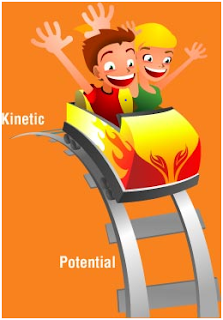1. Conservation of Energy
2. Law of Entropy
3.Absolute Zero
The first law of thermodynamics says that energy cannot be created or destroyed. Energy can be transformed and transferred.
Many different types of energy exist:
- kinetic energy
- gravitational potential energy
- mechanical energy
- chemical energy
- electrical energy
- light energy
- heat energy
- sound energy
- elastic energy
- nuclear energy
Kinetic energy describes movement.
On the other hand, gravitational potential energy is energy due to an object's distance from the ground. This is usually measured when the object is static.
Gravitational potential energy and kinetic energy combine to form mechanical energy. Mechanical energy is energy produced due to the movement of objects. Mechanical energy assists many machines.Some simple machines aided by mechanical energy are are incline plains and levers. Other machines that make use of mechanical energy are pulleys and screws.
Chemical energy is caused by chemical reactions. It can be called chemical potential energy because there is energy stored in the molecular bonds ready to be used.
Electrical energy is caused by charged particles that produce an electrical current. The particles are always moving. On a molecular level this type of energy is kinetic.
Light energy is a form of kinetic energy that emits light (visible or non visible to the naked eye). Sometimes, light energy goes hand in hand with heat energy.
Heat energy is energy stored in objects above absolute zero. This would comprise of all objects. Heat energy can be either potential or kinetic.When an object is heated, the particles in the object contain more energy and bounce off each other faster. On a molecular level heat energy is kinetic.
Sound energy is energy caused by vibrating object. Vibrations are movements of waves in the air. In this sense sound energy is kinetic.
Elastic energy (i.e. spring energy) is potential energy. It is shown whenever and object is stretched. Springs get either compressed and pulled. Elastics can be stretched out. When someone points a stretched elastic at you , it is an instinct to pull away. This is because people are aware of potential of the elastic to hit you.
Energy is essential to our lives and well being. Without it, we cannot form chemical bonds in our stomachs and digest the food we eat. Likely without energy we would not exist due to absolute zero. It is important to remember that energy is never lost. It is transformed into different types of energy.


